"You know, this carpet you are standing on was bought in Bukhara in 1991” said Astrid - Lisa’s grandmother - to her, while they were in her Stockholm-county apartment. Her grandparents had in fact travelled around Uzbekistan and Russia in 1991, at the dawn of the collapse of the Soviet Union. Writing this today, while being in Uzbekistan, sparks our imagination about what must’ve been a once-in-a-lifetime journey. Although they never liked the beach or warm countries, why Lisa’s grandparents decided to take this unusual trip remains something of a mystery. This is how the start of this Uzbek carpet story goes back 35 years.
It was a cold morning in Bukhara. Our first cold morning. The temperature during the night fell to 0ºC, and we had not turned the heating on. Leaving the bed, the foot Xavier set on the van’s floor almost froze. We needed a carpet. Little did we know that this idea would open the Pandora box that are Uzbek crafts.
We were in luck, for Uzbekistan in general and Bukhara in particular have been known for centuries for their carpet weaving. What Bukhara is also great for is selling those carpets to hordes of tourists that reach it by the busload to spend a few days in town. We clearly didn’t know about carpets much more than any other tourist, but we had time. We started by asking for prices in the many (many!) little carpet stores and the answer was systematically a dollar-price followed by
“But I give you good discount. I make good price.”
We quickly realized that prices were rather fluid, and that we did not really know what the good price was. That same day, we were drinking a tea when two men sitting next to us introduced themselves. One of them was a very knowledgeable tourist guide, whom we immediately asked for advice about our carpet operation. He said that one should aim to pay 1/4 of the starting price, but this requires to leave a store and return many times, over multiple days. It sounded just like the challenge we were looking for.
We also learned that the handmade carpets fell into a few categories:
Silk carpets: each “pixel” is a handmade knot made with a colored silk thread. One 100cm x 80cm carpet takes one person multiple months to make. They are the most expensive and look satin. While they are true works of art, they don’t match our style.
Wool carpets: they are made of wool from either sheep or camel. Two different techniques are used to make these carpets. They can be hand-knotted (same as the silk carpets) or woven (which is faster and cheaper than knotting and produces simpler, more geometric designs).
Almost all carpets you will find in Bukhara’s trading domes are naturally dyed, this means the vibrant colors come from pomegranate peels, saffron, indigo, walnut shells or onion skins, among many other plants. The sellers also insist on the fact that you can wash these carpets without worrying about the color transferring - this isn’t the case with artificial dye. All these arguments can contribute to one’s feeling of being in a tourist trap, but in reality - and one can understand this only by spending time in Uzbekistan - Uzbeks are just very good carpet makers and care about quality and traditions.
Despite the many price fluctuations (the same carpet could cost twice as much when asking the price to a different seller) it was easy to realize that silk carpets were totally out of our budget. Also, stores exhibit these rugs like paintings, and they feel somewhat delicate. People here put them in their homes where they would never, ever, wear shoes. In our van, it takes two days without cleaning for the floor to look like a vegetable garden. Not the ideal place for a carpet that required three months of an artisan’s full-time work to make. Wool carpets, instead, are exhibited directly on the floor, and although they are for sale, people are welcome to walk all over them with their shoes on. They feel and look sturdier and like they hold a million stories. This is the type we decided we would get.
We stumbled upon the most expensive and stocked store in town, a place for seasoned collectors more than for souvenir hunters. The owner, a kind man in his 70s, asked us where we came from. He then proceeded to tell us “Oh yes, Switzerland, with Genève, Lausanne, Neuchatel, and Yverdon speaking French, but Bern, Zürich, Winterthur, Basel speak German, and Bienne is in between. But my favorite place is Davos: you drive south from Zürich and make it to Chur, from there the road goes up, and there’s even people there speaking Romansh!”. After months spent systematically explaining where Switzerland is, we were surprised to say the least. Lisa joked he knew Swiss geography better than her (as a matter of fact, he did). “How do you know all this?” we asked. “I was doing the carpet purchasing for Pfister Möbel for 40 years. Sourcing all the best Turkmen, Uzbek, Tajik, and Persian carpets. But I’ve stopped now. I’m only left with my own five stores around the world and some eager collectors to which I ship. A little operation, really…”. Needless to say, most of what he could show us was out of our budget, but every piece had a unique story, and this man was a great seller. We spent an hour absorbing his passion for carpets. “I tried to retire, a few years ago. After one week, my wife couldn’t stand having me in the house the whole day. I’m back to spending my days with carpets”.
Our hunt for a wool carpet was on, but soon we hit the first roadblock. It appears that carpet makers completely ignored the van-floor-sized-carpets niche. You can easily find small doormat-sized carpets. Or very large living-room-sized carpets. You can even find 4m-long runners. But you can’t really find a 60cm x 120cm rug, which is what we needed. The numerous negotiations that we had started all over the town started crumbling under the crushing authority of a meter, which showed that everything we had made an offer for was just unsuitable. Ultimately, only one kilim (a bright colored woven wool carpet) was remaining. The seller had started by asking for 130$, and we had offered 25$. It might make you uncomfortable to start this low, or make you think we’re arrogant. But bargaining is a local sport in Uzbekistan. As long as the seller discusses, you’re on the right track. You’ve gone too low when they just shake their head and say “No, no” and don’t offer another price. Many mock cries and much pretended indignation later, the spread had reduced, but no player wanted to compromise. We returned systematically over the next few days, further closing the price gap, but couldn’t find a deal. What we had learned was that Bukhara was not the right place for us. Sellers here are used to dealing with tourists that are around for one or two days, and whose vacation lasts 10 to 15 days. They are tight on time, do not bargain, and are ready to pay whatever price the seller says is a good price. By this point, we were practically living in Bukhara, and not feeling like tourists anymore. We had become so accustomed to the town that we even called its evening samosa seller by his name. As he was walking around town with his basket full of freshly baked savory pastries, we smiled “Hi, Jerry” and his surprise caused him to burst into the most genuine laugh we’d heard in a while.
Feeling like locals, we were curious to find out where the real locals buy carpets. Our guess was based on the idea that if the city center was for tourists, the city’s outskirts were for locals. We were quick at finding the modern carpet stores where Bukharans buy. We were even quicker at realizing we really did not like these carpets. As much as our romantic views might lead us to believe that the locals own ancient carpets in their homes (and some do), we all know the Swiss don’t all own an alphorn. Instead of antique, the Uzbeks have modern, more affordable carpets and appreciate a very different style based on thin dark motifs on a pearl white background. Stocked by the thousands in large warehouses outside the main city center, these carpets look extremely cold, and appear to be made with synthetic fibers, most likely in China. Once again, not what we were looking for.
Lisa had spent countless hours trying to understand what the best place was to buy textiles in Uzbekistan. The answer seemed to be the Urgut bazaar. Urgut is a town that is entirely out of tourist routes. For a reason: there is nothing to see or do here. However, on Wednesdays and Sundays, in Urgut takes place the second-largest market of Uzbekistan, with a focus on rugs and embroidered fabrics. Conveniently, we had left Bukhara to reach Sharisabz, and our drive from there to Samarkand happened to flank Urgut on a Wednesday.
We reached Urgut, parked our van in the messy, crowded and wet surroundings, and crossed an ocean of stalls and stores flooded with Chinese goods. This place would’ve discouraged any traveler on a two-week holiday and on the hunt for exotic, photogenic scenes and unique souvenirs. We traversed the entire market and reached the end of it. This is where the traditional fabrics are sold on Wednesdays and Sundays only: many of the sellers have other jobs, and rugs and embroidery trading is just a side hustle. We were the only customers around, and once we appeared like serious buyers, we immediately got pulled inside a store. Starting prices were much lower than in Bukhara, and vendors more eager to sell. Stores here are also not displays of art, they’re more like small warehouses; you need to pull every rug out of a pile to get a look at it. You can’t go incognito.

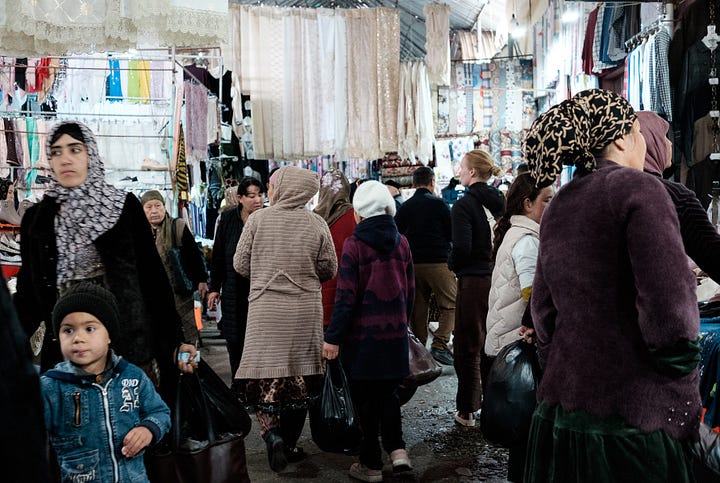
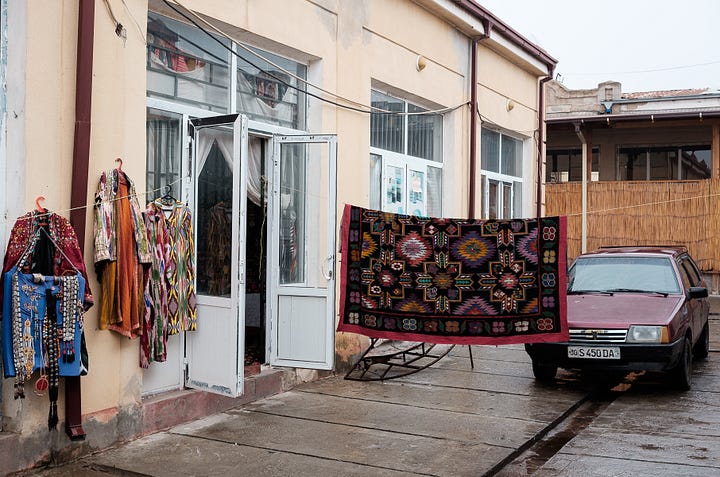
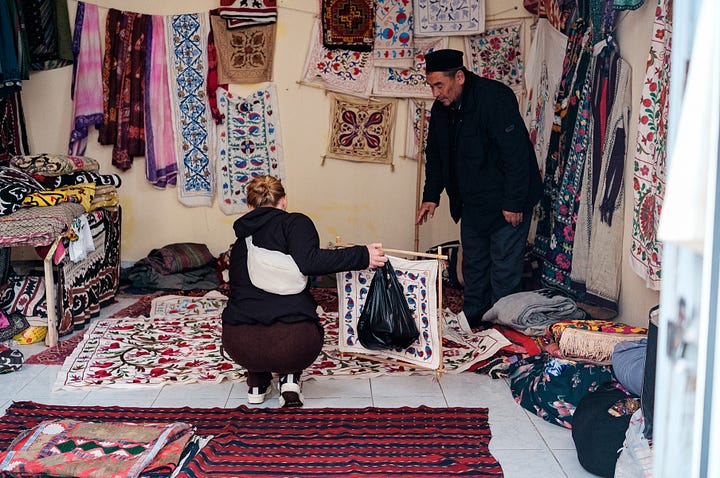
It was a slow day it seems: other sellers waited for us in front of the store we were in, so that they could drag us into theirs as soon as we left. “Just looking” they assured us. However, the pressure was high, and after just ten minutes we found ourselves needing a break. But this pressure was good news: we had leverage. We declared that we were going for tea, and darted away (this method has become our go-to when locals are pressing us for something: we say “Choy” and make a circle gesture with our hands to indicate we’ll be back. It works every single time).
Our tourist faces got noticed by a group of women having breakfast while crouching in between their stalls. We were invited to sit with them, and received a hot drink and some stale bread which they dunked in the cup to make it chewable. After a few sips of what we learned is a mix of tea, instant coffee, and sugar, Xavier realized that the cup he was given belonged to the oldest lady of the group, who was also introduced to us as the Mother of the Bazaar. She had stopped mid-drinking to hand him the cup, stale bread floating in the tea included. After asking us (as every single local) if we were married and had kids, we took some pictures in a holly mood and were on our way.
We returned to the carpet and textiles shops, and after thoroughly rummaging through five stores we felt observed, overwhelmed and unable to get away. What we really wanted was to have a look on our own, but there was nothing that seemed more remote a possibility. We uttered “Choy”, the magic word, and walked out of the crowd. Before we could sit down at the tea stall, a man we had noticed earlier by the carpet shops appeared. He talked to the waiter, who proceeded to hand him a teapot, and then he walked over to us. Our puzzlement was short-lived: he was very obviously subtly conducting a business strategy which consisted of gifting us the tea and standing so close to our table that we would feel pressured to drink fast and go back with him to his store. Lisa wasn’t having it; she waved her hand as a sign for him to sit down next to her. She started asking him all sorts of monosyllabic questions - Russian skills lacking - about details she had learnt throughout her detailed search for suzanis - typical Central Asian embroidery. This achieved two things: he stopped rushing us to drink our tea and he understood we knew a thing or two about carpets and suzanis. He showed us pictures on his phone of carpets and antique suzanis that were apparently over 50 years old. Lisa asked “How do you know they are over 50 years old?”, which seemed to offend him and throw him off. He said “I am in the business”. She then explained that unless he could demonstrate to her that these were indeed 50 years old, she couldn’t see the difference between a new one and an old one and therefore couldn’t understand their monetary value - it was a loss for him. Nevertheless, the tea-trick had worked, for we soon found ourselves dragged to this man’s little store.
The seller started pulling rugs out of the piles against the walls and throwing them at the center of the room for us to see. We had little discussions about items we could be interested in, but so far we hadn’t seen our carpet yet. We explained that we are living in our car, and thus needed a wool carpet with a very specific size. The man’s eyes shone: “I have special carpet for you”. From under a table, he took out what looked like a huge jute tote bag. We were confused. As he turned it, however, we saw that one of the sides of the bag had been made with a 60cm x 120cm knotted wool carpet. “More than 40 years old, camel wool, very special!” It was very special indeed, and the perfect size, but it was a bag. The seller explained that it would be no problem to cut the carpet out of the bag, right there and then. We loved the idea: this old carpet-turned-bag would finally become a carpet again, and it had a nice story to tell. Someone had already found scissors for the upcoming surgery. We began haggling for the price in front of the usual crowd of other sellers that had gathered. We drove a hard bargain from the get-go. What made it different from previous attempts done in Bukhara was that everyone involved was serious: we wanted to buy, the man wanted to sell. Returning tomorrow was not an option. The opening moves from both sides were - as usual - wild attempts at anchoring the price with an unreasonable offer. The crowd was quiet. While the discussion continued, we realized that the volume of the murmuring from the onlookers indicated that the game was tight, but fair. There were eight pairs of frowned eyebrows, with a focused attention and sharp curiosity, holding their breath for what would be the outcome. As we made our last offer, the entire crowd was taking part in the negotiation, with outraged screams at us and unrequested advice to the seller. We knew we had found the best price, precisely because it caused indignation and involvement, not indifference. The seller, after much thinking, conceded, and the dance was over. We had a carpet.
We really like it when you leave a comment, so please do!

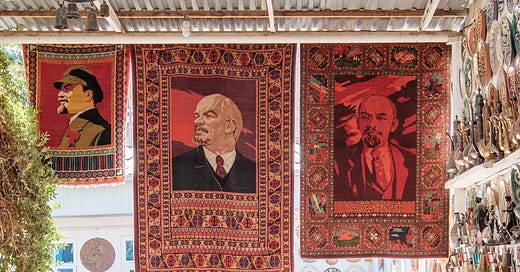



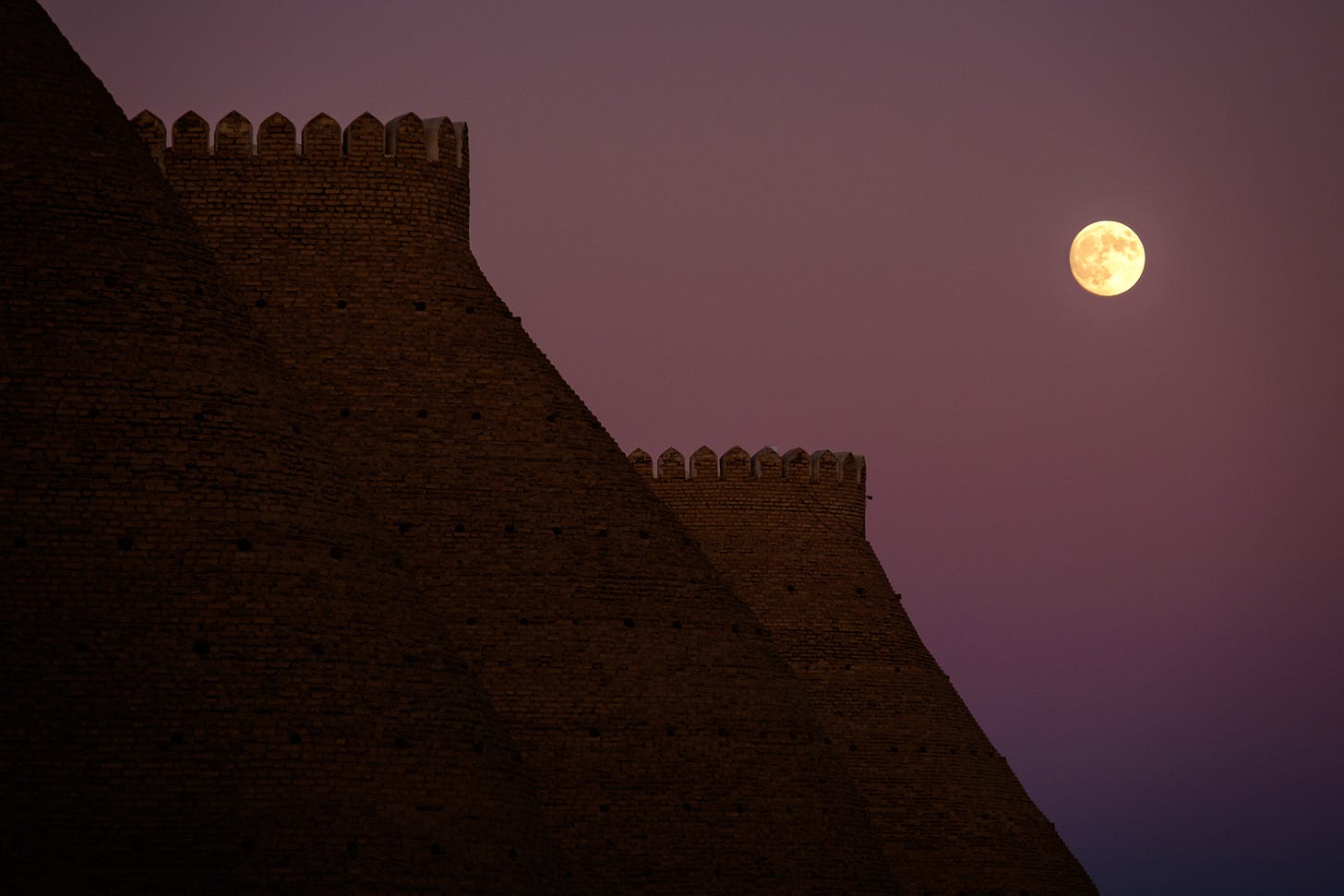
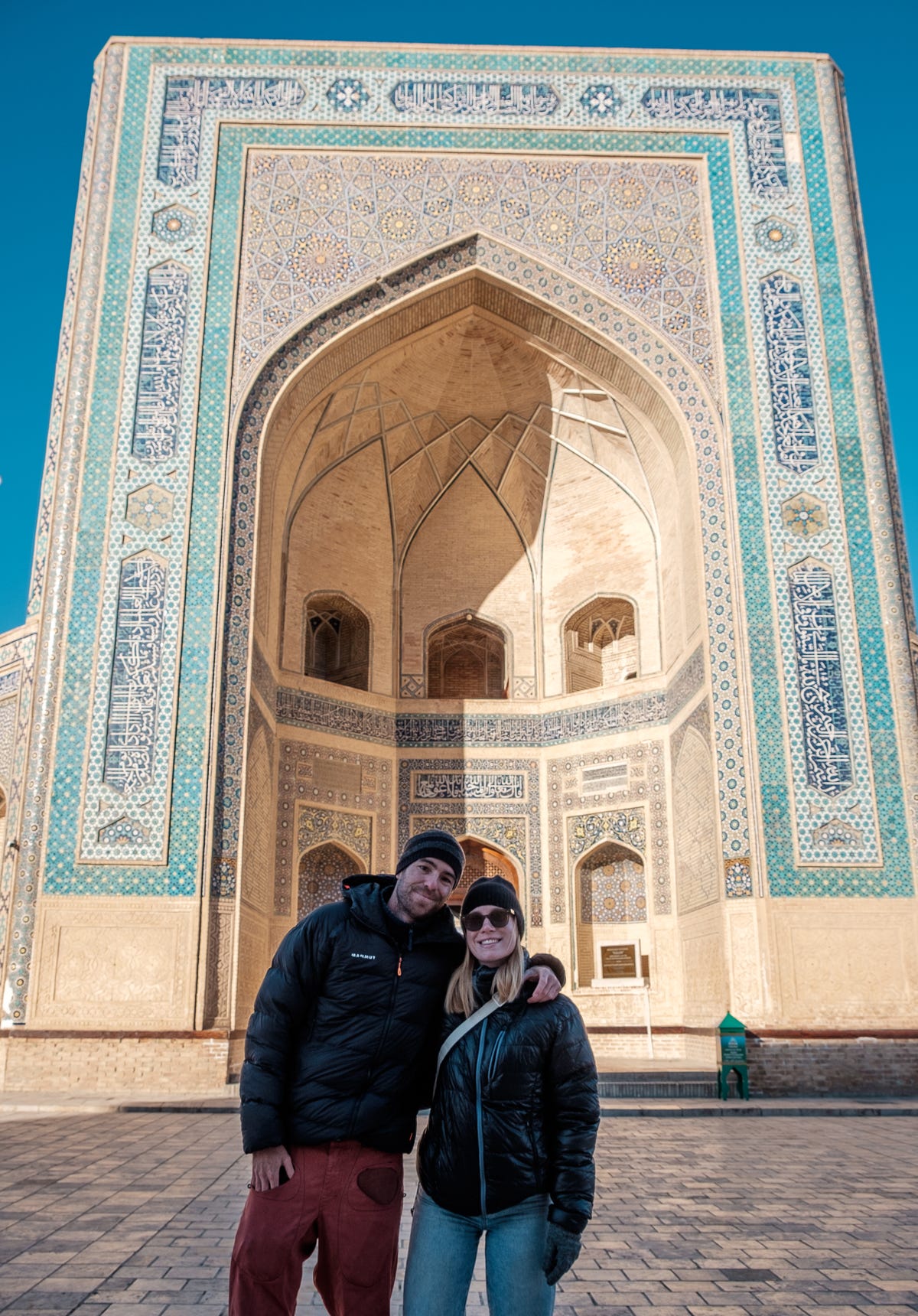
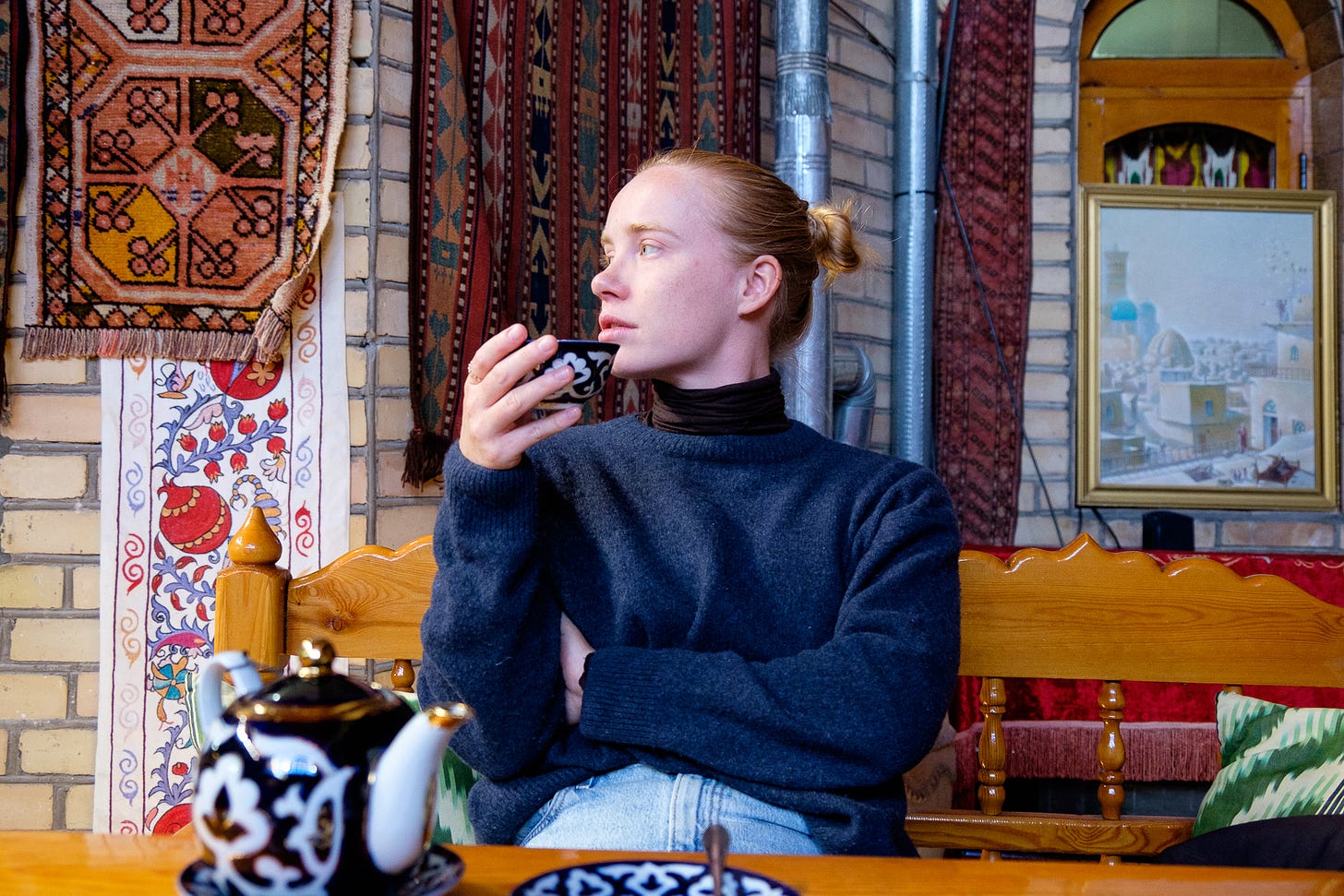
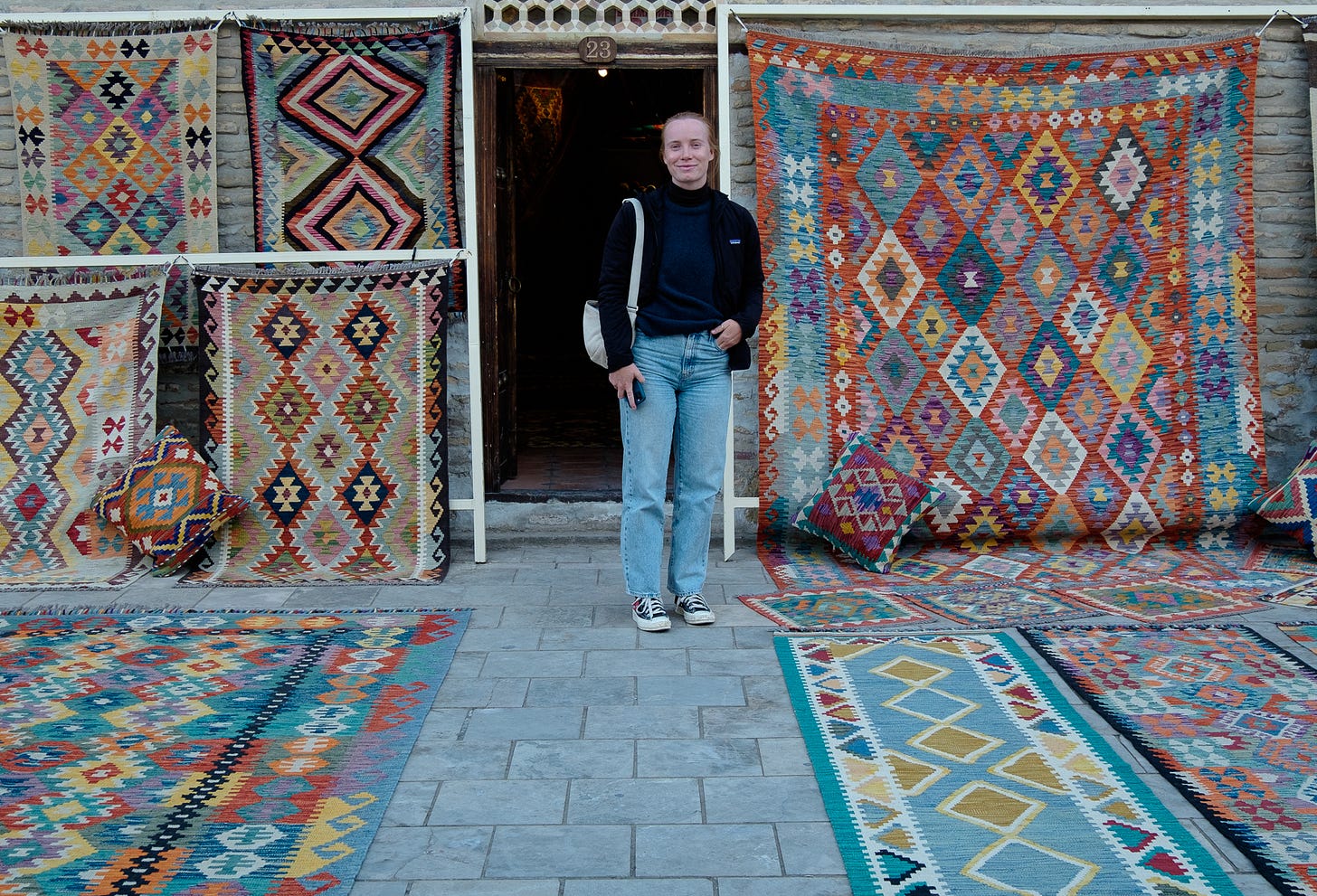

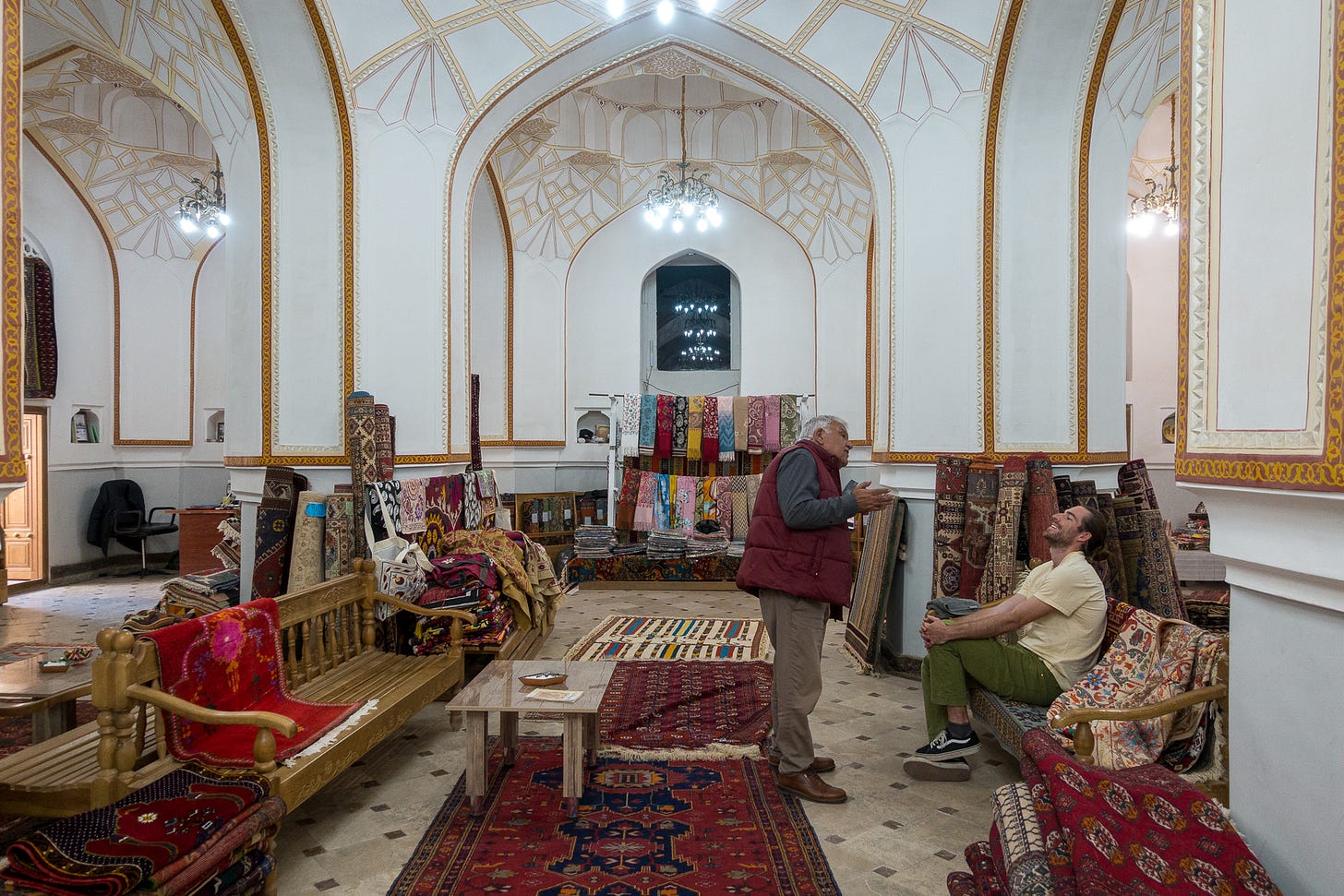

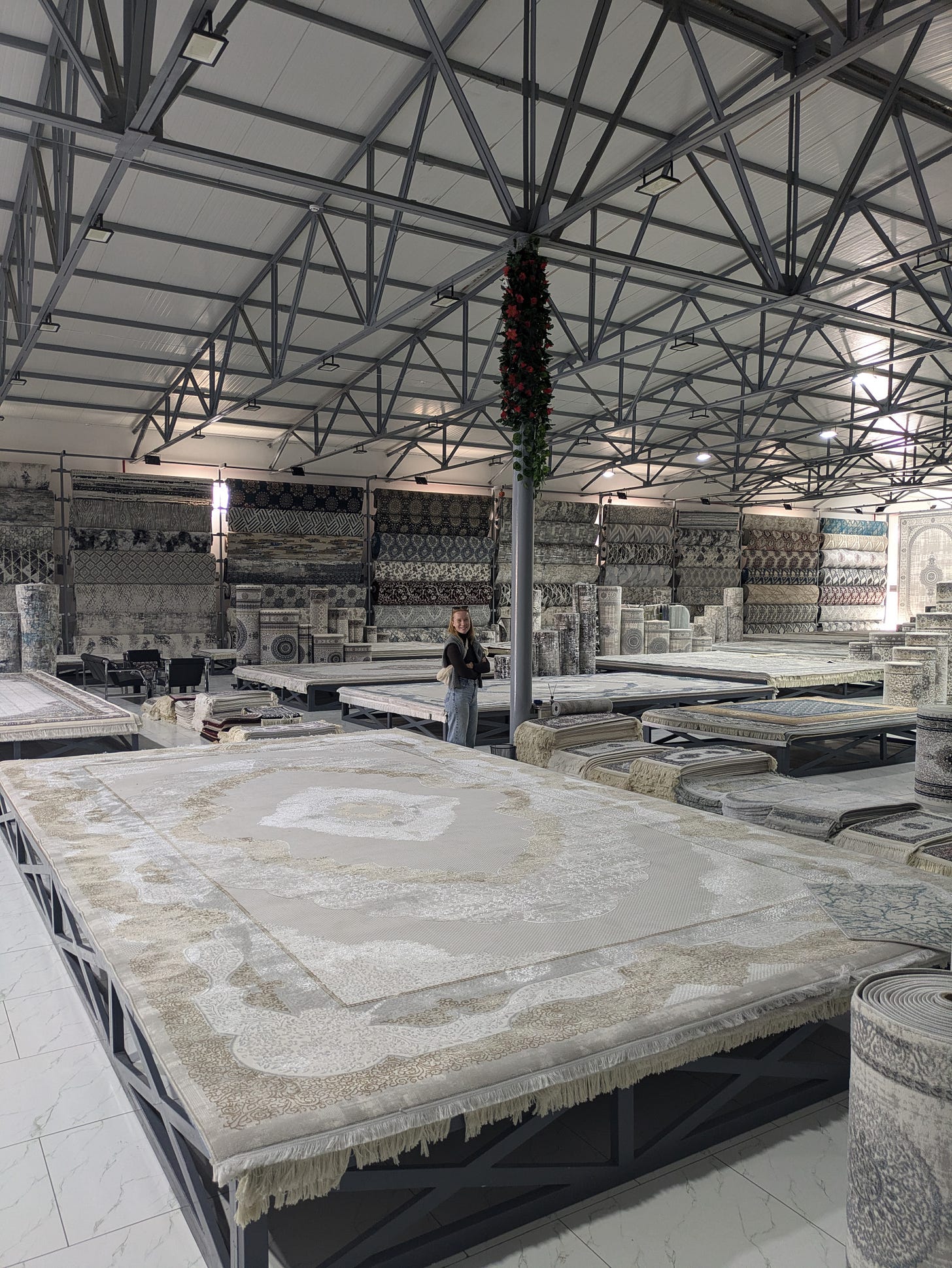
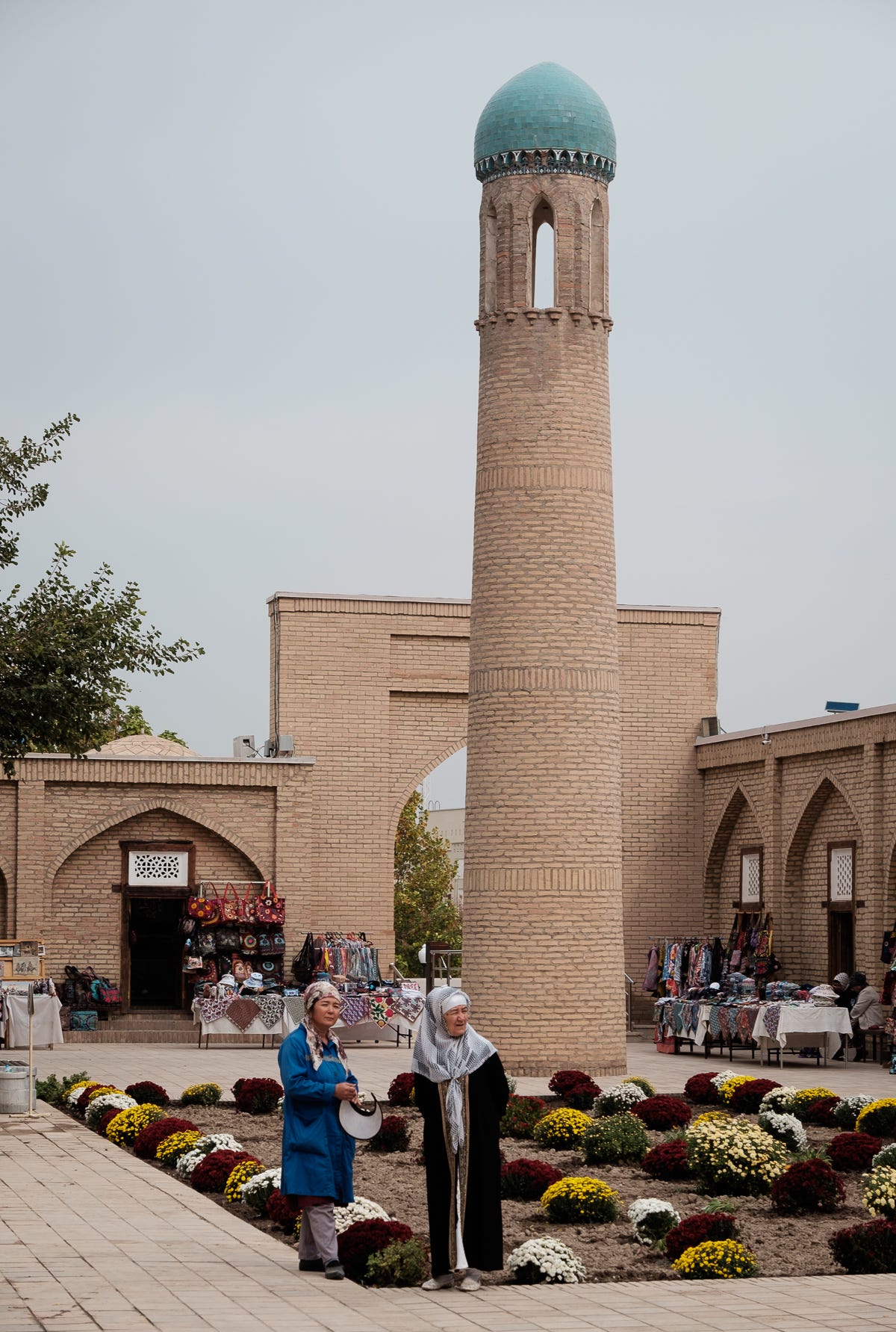

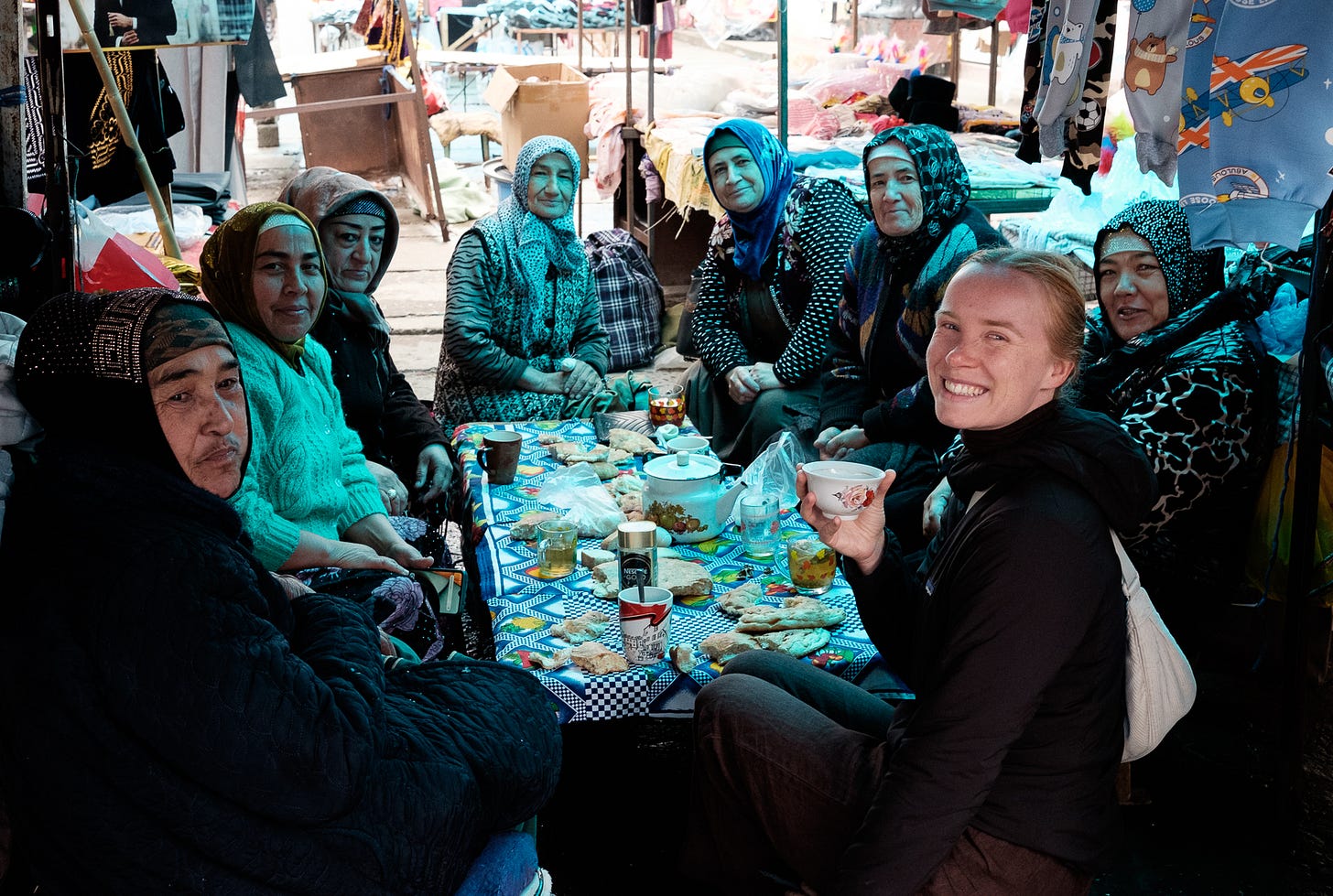

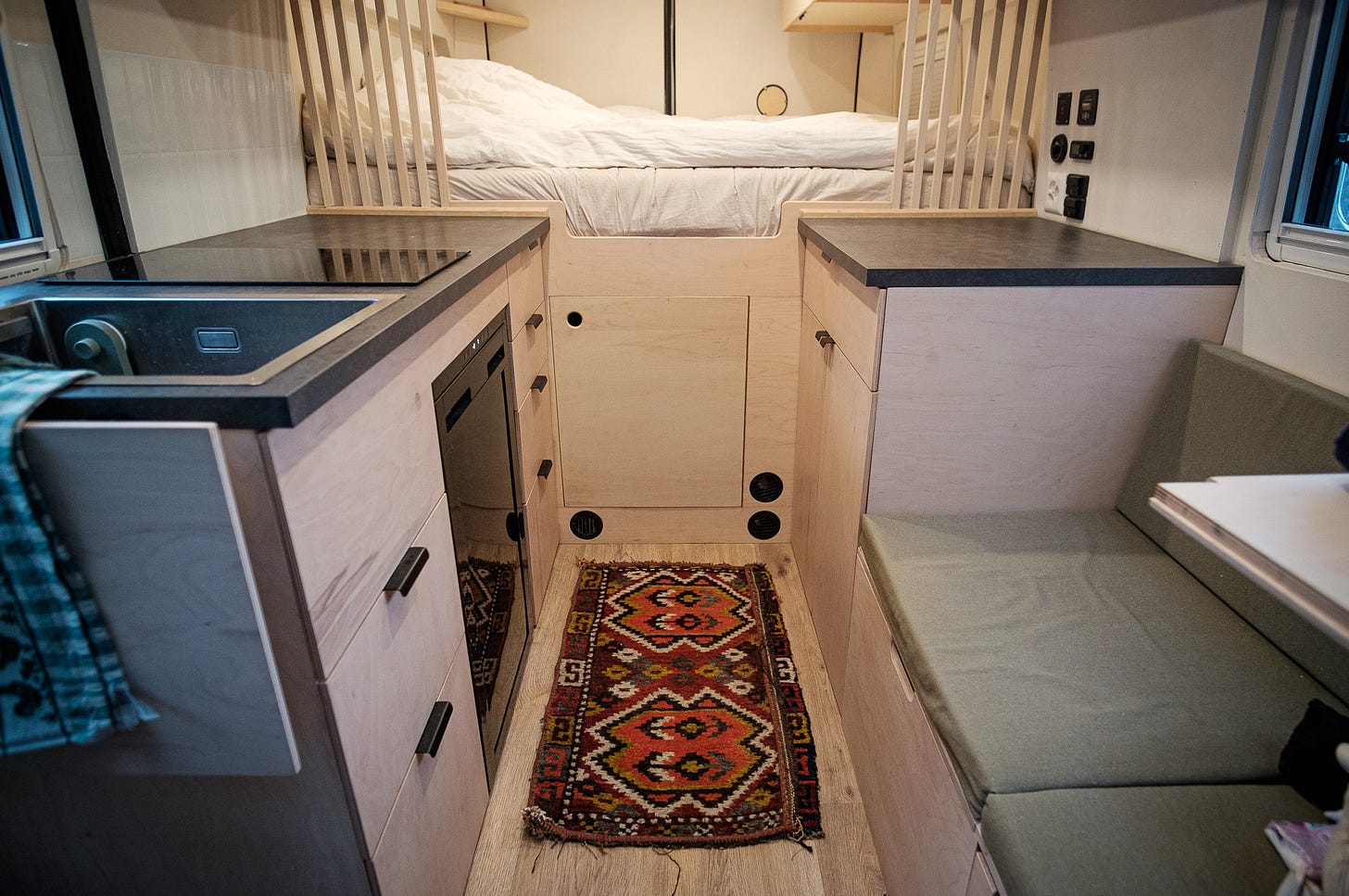
Hi Xavier and Lisa, yes, how interesting!, in Iran also Carpet is so common. I personally do not remember a house without being fully covered by carpet. Also people do not like machine carpets, because it is a bad sign, like you are low prestigious. Carpet should be of silk and hand-woven (like sign of your social level and originality). One other thing is about "Bukhara". This city is very much respected in our Persian poems. There is also "Samarkand" city in Uzbakistan so famous in Persian culture(by the way "-istan" in name of countries is a Persian suffix meaning "land" so Uzbakistan means land of Uzbaks(a race name)). A famous verse from Hafez Shirazi (my favorite poet!) :
"اگر آن ترک شیرازی به دست آرد دل ما را / به خال هندویش بخشم سمرقند و بخارا را"
(translation is reserved, but knowing the meaning is recommended!!)
Il vostro racconto è talmente intrigante che per un attimo mi sono ritrovata con l'immaginazione a sorseggiare un buon the nel bazar di tappeti uzbeko!!! 🙏😊